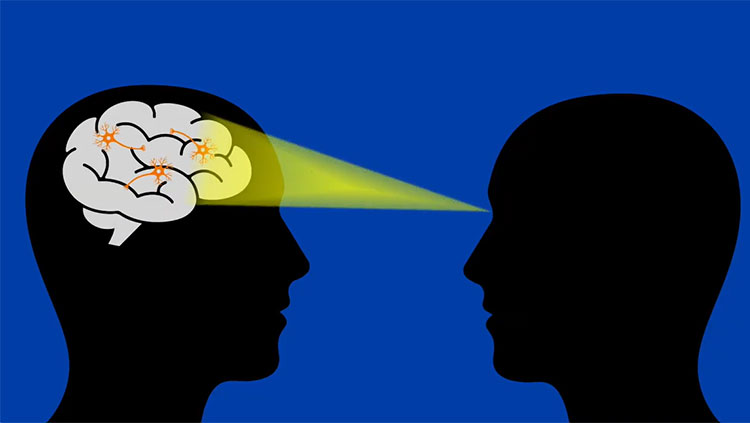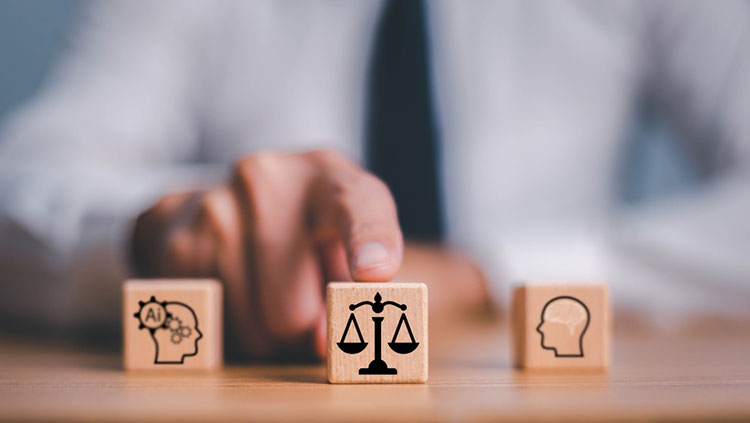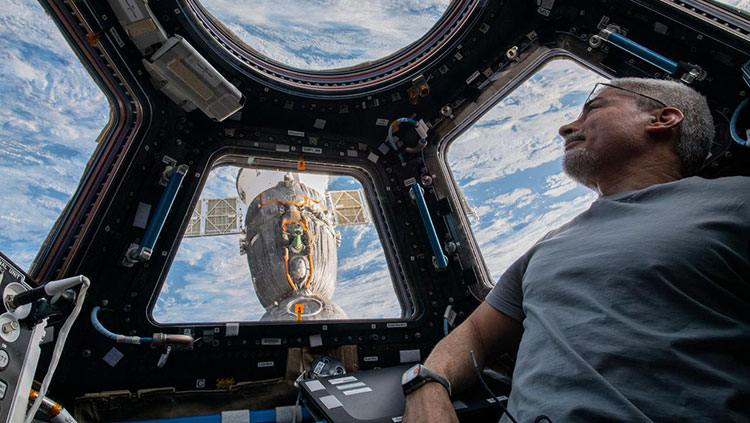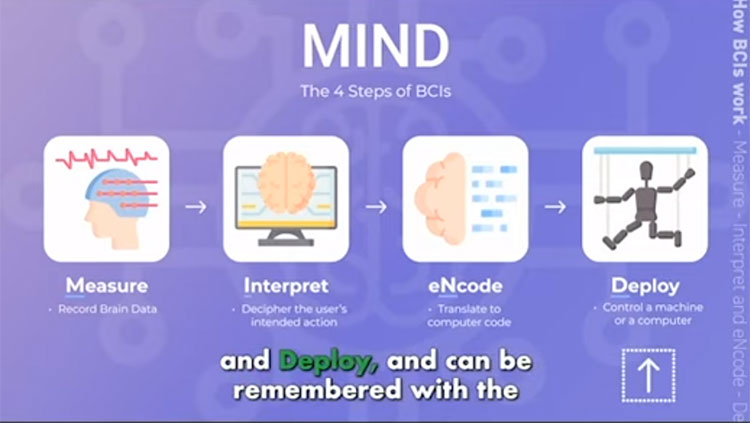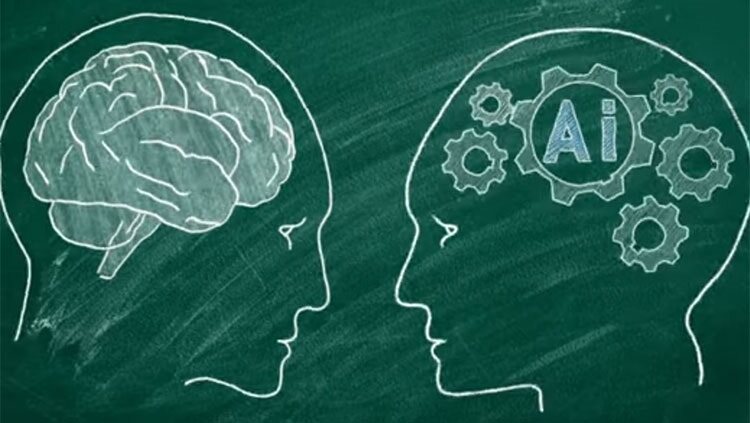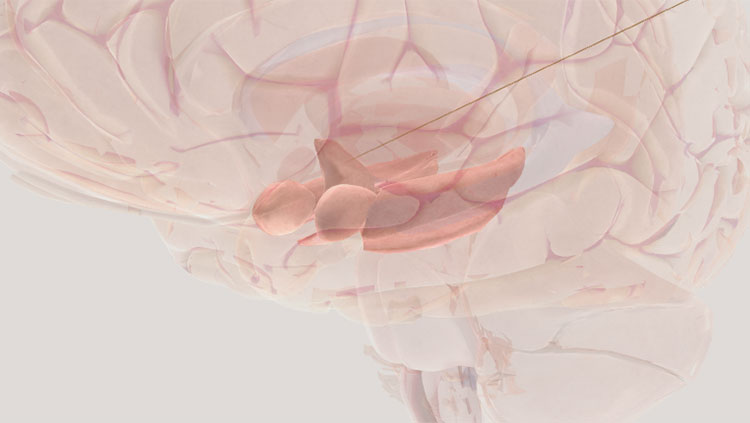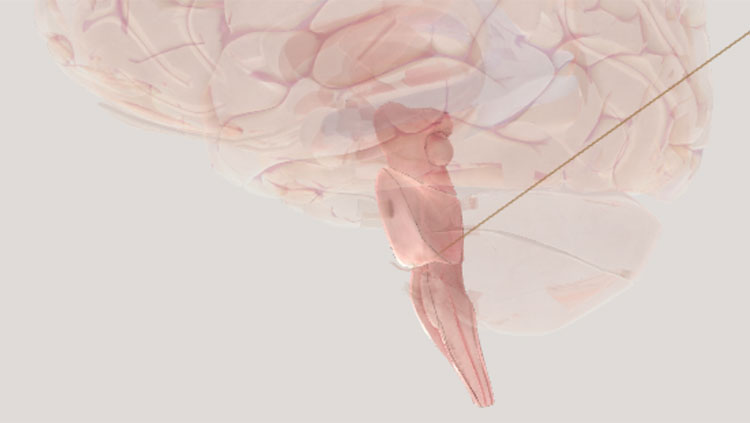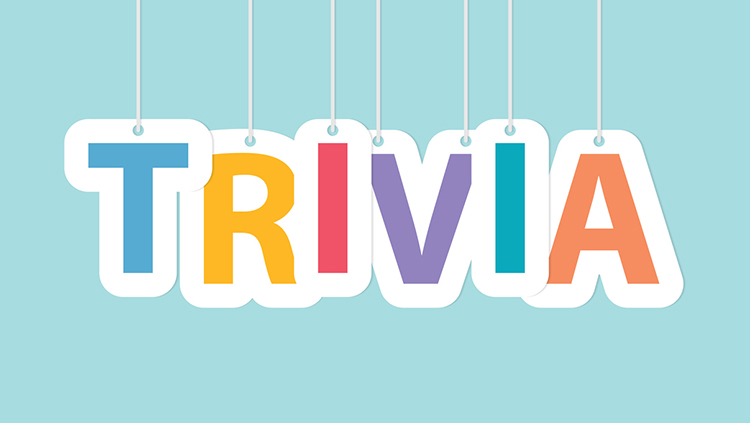Uploading the Brain
- Published26 Jul 2018
- Reviewed26 Jul 2018
- Source Knowing Neurons
In a brand new episode of the Knowing Neurons podcast, we explore the concept of “mind uploading”. How would something like a mind upload really work? How close are we to uploading our brains right now? What kind of ethical, social, and legal challenges would it bring up? We investigate with special guests Dr. Adrienne Fairhall, Dr. Rafael Yuste, and Dr. Randal Koene.
Resources and a transcript for this episode can be found below.
CONTENT PROVIDED BY
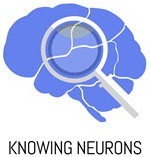
Knowing Neurons
Transcript
[transition: series of modern tones]
Wait, mind uploads? Is it actually possible that sometime in the future, we would be able to upload our brains into a digital format, allowing us to essentially live on for…well, forever?
Theoretically, getting our organic brains into an immortal digital format would be broken down into two main steps: making a copy of the human brain and then copying it onto a digital format. Kind of like “reading” and “writing” onto a disc. Sounds simple enough…right?
Reading the Human Brain
KNOWING NEURONS: [inquisitive jazz music plays for a while] Making a copy of the human brain, however, is more complicated than copying and pasting a brain scan, like an MRIMagnetic resonance imaging, a technique for viewing the stru..., onto a hard drive. The digital upload would need to have your memories and your consciousness, so that it could be dynamic – a seamless transition between your organic consciousness and your digital one. But our memories, as we currently understand them, aren’t quite like individual files that you can drag and drop – we can only access them by recalling them. The more we recall memories, the stronger the connections among the neurons involved become. The less we recall them, the weaker those connections get. (In neuroscience, this is generally called long-term potentiation and long term depression, respectively.) So to copy over the memories, we would need to copy the entire network of neurons and the interactions among them to help us actively recall those memories, as well. Essentially, this means bringing the whole human consciousness along for the download…which is where things get a little complicated (as if they weren’t already).
Scanning the neural network of the the human brain means going deeper than the outer folds and grooves of the brain, deeper than the tissues themselves, even deeper than the cellular level of 100 billion neurons, all the way down to the trillions of connections among those neurons, and even the molecules that allow neurons to interact with each other and communicate. Even then, neurons are a social bunch – they don’t just communicate amongst themselves, they talk to the spinal cord, to sensory receptors throughout our body, to muscle cells, and so on.
Obtaining a map of the brain’s molecular-level connections (or connectome) is no easy feat. Usually, the best way to get such high-detailed images would be to…slice brains up into thin, tiny slices and scan them. Researchers have actually used this technique to compose cellular-level connectomes of a single fruit fly, of the mouse, and – perhaps the most detailed and complete connectome so far – of the C. elegans (a nematode worm).
While these efforts give us hope that a human connectome might be possible in the distant future, they also raise a few concerns. Firstly, the human brain is much more complex than the nervous system of these animals. There are even more variables at play that we might not be able to copy, even at the molecular level, as Dr. Adrienne Fairhall, professor & computational neuroscientist at the University of Washington in Seattle, explains.
DR. FAIRHALL: So when people think about uploading your brain, and that will – if you capture your synaptic connections, then you will be able to – that that will capture sort of the state of your memories. I believe that a lot of the machinery that we have for memory is not just built in at the synaptic level, but it’s also built in in terms of the excitability of neurons. And so that’s kind of invisible to the connnectome, right? If you think about the connectome as defining the brain – the fact that neurons can reset their intrinsic excitability and change their ion channel concentrations so that their processing properties change – that’s just a completely different way of storing memory that wouldn’t show up in a method like that. Those excitability properties are modulatable by homeostasis and all kinds of other mechanisms over timescales, ranging from hundreds of milliseconds up to minutes to hours to days. So there’s many other dynamics that are involved that we would need to understand.
KNOWING NEURONS: Second, many of us may not want to opt for such an invasive procedure – to have our organic brains sliced up in order to image them and compile them into a digital format. More research on connectomes and non-invasive imaging technology will go a long way in making human brain mapping a more plausible reality.
Other scientists, like Professor Rafael Yuste of Columbia University in New York, think that mapping neuronal activity instead of just taking a molecular snapshot of neurons, might help us achieve the same end goal.
DR. YUSTE: We’re interested in understanding how brains work, and we belong to the School of Neuroscience that thinks that the critical level at which brains operate have to do with groups of neurons working together. In other words, that the function of brains – or actually of nervous systems or neural circuits – is an emergent property of the interactions between neurons. And neurons can interact in space and in time, no?
Let me just give you one example. This is just like watching TV in your living room at night. When you watch a movie on a TV and you see an image, the image – it’s an emergent property of the interaction between pixels. So pixels are changing in brightness and in color, and it’s these correlations between pixels in space and in time that generate these structures which are the shapes that we can now perceive as the building blocks of, let’s say, the movie that we’re watching.
If brains operate like this, then we’re not going to be able to understand what’s going on by recording the activity of individual neurons, one by one. It’s a little bit like trying to watch a movie by looking at one pixel on the screen. So what we’ve done and I think what needs to be done is to watch the whole TV screen. In other words, to record the activity of every neuronThe functional unit of the nervous system, a nerve cell that... in the nervous system so that we can actually catch any potential correlationAn association between two quantities such that one varies w... that is going on between neurons in space – across the body of the animal or the brain of the animal – or in time.
KNOWING NEURONS: Dr. Yuste and his team recently recorded the entire neuronal activity of a hydra – a small and transparent creature related to jellyfish. Hydra may have the simplest nervous system in nature – a nerve net that spreads throughout the body – but this research study was no small feat.
DR. YUSTE: I think we’ve done this for the first time – I mean people are getting close to doing this in other animals, but no one has actually gotten to the point where they can record the activity of every neuron. In fact, in some of these movies, we think we may have recorded every spike from every neuron. In other words, the complete record of neural activity.
We did this using a method called calcium imaging, which is a method that we introduced as a way to catch the activity of neuronal populations and essentially consists of putting a fluorescent calcium indicator inside every neuron and then using fluorescent microscopy to detect changes in fluorescence in the neuron that are a reflection of the action potentials that the neuron has when it’s activated. So we essentially have made a movie, which you can download from the web, of every neuron in the hydra while the animal is moving and behaving.
And just to finish – why hydra? Why is this animal interesting? Well, hydra is an example of one branch of the tree of life, which are called Cnidarians. Cnidarians are animals like jellyfishes, sea anemones, coral, hydra – hydrazones. And these are the first animals in the tree of life that have neurons. So in a way, we’re looking at the animals that could have the simplest nervous systems on Earth – the simplest nervous systems as they’ve emerged in evolution. And for us, this is a wonderful model animal because it’s in a way the – [chuckle] the simplest you can think of, no? So let me put it differently, if we cannot understand one of these Cnidarians [laughter], then I’m not sure how we’re going to understand more complicated animals, like mammals like ourselves, no?
KNOWING NEURONS: Now, Yuste and his team are working to crack the hydra’s neural code in the hopes of building a computational model that can predict the hydra’s behavior, just from neural activity alone. Adopting similar techniques and approaches to more complicated nervous systems in other animals may be possible sometime in the distant future.
“Writing” the Human Brain
KNOWING NEURONS: [futuristic driving beat music plays for a short while] So, let’s say we’ve advanced to the point where we can capture a molecular scan of our brain. What next? Well, first of all, we’d need to have the right digital technology to keep up with our cognitive requirements. For starters, we’d need a massive amount of digital storage. A cellular-scale image of an entire fruit fly brain, for instance, takes up a whopping 26 TB (https://knowingneurons.com/2017/12/13/fruit_fly/). According to scientists like Paul Reber, professor of psychology at Northwestern University, the human brain could contain about 2.5 petabytes (or 2,500 TB) or so of data storage. Depending on the resolution of the images and post-processing techniques, that number may be even larger as a digital format. With the way technology is advancing, however, higher data storage options likely won’t be a limiting factor.
But we’d also need to consider the speed and computing power of our digital brains. There are trillions of connections among neurons and the cells they communicate with, with some of those connections transmitting messages up to 400 km / hr. A few researchers, however, have stepped up to the task, wielding the power of supercomputers (https://youtu.be/Ldr_ewvNHw8?t). In 2012, researchers at the Lawrence Livermore National Labs used the IBM Blue GeneA sequence of nucleic acids that forms a unit of genetic inh.../Q Supercomputer to simulate around 530 billion neurons and about 100 trillion synapses, or connections. The researchers clarify in their work that it’s not a “biologically realistic simulation of the complete human brain”, but it is an interesting exploration of the kind of computing architecture a digital brain may require. While impressive, the simulation program still ran about 1,500x slower than an average human brain would. A year later, in 2013, Japanese and German researchers used the K supercomputer at RIKEN in Japan to simulate 1.73 billion nerve cells and 10.4 trillion synapses. Now, the K supercomputer has a performance level equal to 1 million linked desktop computers and a combined memory power of about 250,000 regular PCs – but even then, the supercomputer could only simulate about 1% of human brain activity for a single biological second (taking 40 minutes of real time). The increase in technology is certainly promising, but it seems we have a way to go before we achieve a truly powerful setup to handle our human brains.
There’s also another unique feature of digital brains that we need to consider. Generally speaking, in our current organic bodies, we have the power of privacy. We can go through our entire days having this personal dialogue with ourselves, recalling memories, having thoughts, and no one else can peek through our head to see them. Most of us can share our thoughts on our own terms, when we want and how we want. However, our digital brains don’t have this privacy feature built in. We would need to make sure that our digital uploads had the appropriate countermeasures built in, with protection against hackers using viruses and other malicious software. If we wanted to have some of the same senses that we had in our organic bodies, we might also need additional sensors and software added to our digital uploads so that we could interact with our physical environment.
Current Efforts
KNOWING NEURONS: [upbeat modern tech music plays for a while] So how close are we to mind uploads in the world of research and technology? Well, there certainly isn’t a lack of visionaries and enthusiasts trying to make digital brains a reality.
Perhaps the most popular mind uploading initiative is the 2045 Initiative, founded by Dmitry Itskov in 2011. Itskov describes the initiative as a way to enhance human life and help individuals with disabilities or diseases. With the help of a team of specialists in neural interfaces, robotics, and more, Itskov claims that he is trying to create a way for humans to transition into a cybernetic avatar-based lifestyle.
His first goal, which he hopes to achieve by the end of 2020, is what he calls Avatar A, described on the initiative website as a “robotic copy of a human body (or avatar) remotely controlled by a brain-computer-interface (BCI)”. The next milestone, projected for the end of 2025, is Avatar B – the transplantation of a human brain into an avatar at the end of a person’s life. Avatar C, projected for the end of 2035, is an avatar with essentially an uploaded organic mind, with the prospect of control over modifying one’s own brain. Finally, Avatar D, the end goal by the end of 2045, is a hologram-like avatar, presumably immortal. Itskov claims that the Initiative will help progress humanity by allowing people to essentially transcend the limitations of their organic bodies, whether it frees them from disease or old age, or enables them to do more dangerous work or explore places like outer space. Avatar A is possibly the most plausible of the research goals, as some people today already possess prosthetics that can be controlled using BCIs. An entire artificial body and digital upload, however, might be a more complex task, especially if you needed to implement some of the basic senses we experience now in our organic bodies. There’s also the question of emotions and intuition and how to transfer those into an avatar effectively and seamlessly, when we still don’t have a crystal-clear grasp on how abstract concepts like intuition may work.
One of the neuroscientists who has had some involvement with the 2045 Intiative is Dr. Randal Koene, a researcher focusing on what he refers to instead as “whole brain emulation”.
DR. KOENE: Yeah, because there are some terms that get thrown around and they sometimes get mixed up – whole brain emulation and mind uploading. It’s not a very big deal – it’s just that “mind uploading” is an older term and it comes from science fiction, and it talks about experiences of being in a new body or in a virtual body, moving, transcending on. But it doesn’t really say anything about the science or technology that’s behind it, so it’s almost a spiritual thing . It’s like, how do you transcend?
But whole brain emulation is a technology term – it’s a terminology that stands to address what you’re actually trying to do if you’re trying to do something like mind uploading. A brain emulation is the emulation of whole brains or parts of a brain, reconstructing functional processes in neural circuitry. And that’s why I’ve also used the term neural prosthesis or neural prosthetics a lot because that’s very closely related to brain emulation. They both pretty much try to do the same thing, namely to carry out the processing that’s being otherwise carried out by the physiological architecture of a piece of the brain. That’s exactly what this term “emulation” is trying to refer to: it’s this idea – the goal of a good prosthetic to faithfully and correctly reproduce original dynamic operation, and that in turn refers to something that we know of from the world of computing where you know, say, you’ll use – a developer would use an android emulator on a PC or a Mac to build an app that could later be run on an android device. And in that sense, a brain emulation is intended to run your thoughts on a new brain device.
KNOWING NEURONS: And while the organic brain may have advantages like thought privacy, Dr. Koene suggests that having a digital – or rather, an artificial brain – may allow for new functionalities.
DR. KOENE: Well, I suspect that, uh, we’re not really going to see the comparative strengths of biological brains versus digital brains until we really have digital ones to compare them with.
If you have a digital brain, then you can create backups. That means you can restore brain function if there was damage or you can undo problems that occur. You can duplicate digital brains, which means you can run each of your processes, if you want to, in five different places on different machines at the same time, each of them checking one another to establish the unadulterated activity that’s supposed to be taking place. Much like, for instance, today when you store data on multiple hard disks in a so-called RAID system, you make sure that you’re getting the right data. Or if you have a failure-proof aeronautical system in a plane or a rocket, then you give commands through multiple channels to make sure that the commands arrive where they’re supposed to.
Also, your memories could become truly reliable, precise, and never fade. But at the same time, you could choose explicitly which memories you want to keep, and you could emphasize which ones to remove. You could imagine how that would affect both learning and healing of trauma, for instance. And through a process of translating, the way that things like thoughts are mapped in one brain to another, you might be able to quickly learn from the experience of others. If you look at a movie like The Matrix, you’re seeing things like this expressed where , you know, they’ll suddenly say , “Teach me Kung Fu,” or something, “Download Kung Fu” , and they’ll learn that . And it seems so silly and simple there, and it really isn’t because of course, you know , my muscles are wired up to my brain in a very different way than your muscles are wired up to your brain, so if you download a Kung Fu master’s brain patterns, that doesn’t give you Kung Fu. There’s a translation that needs to take place. But still, if you could make those translations, in principle, that’s possible. And similarly, you can do something like this to better feel the sensations or impressions of a different person. And in a sense, you could call that a stronger form of empathy or understanding.
A digital brain could also be moved from one version of the brain hardware to the next, just like you can move a program from an older PC to a newer PC, and that is a kind of upgrade in its performance. You could imagine being able to think faster, say, think faster than biological neurons ever could because biological neurons are never going to fire more than say, 1,000 times per second. But there’s no reason why a digital neuron couldn’t fire a million times per second or a billion times per second. So then, perhaps, you can perceive what the universe is like at the microsecond scale, which are scales that currently only our machines can experience, so that universe doesn’t even exist for us right now. But if you had a digital brain, then that universe may exist.
With a brain like that, you can experiment not just with those kind of enhancements where you run it on a different processor, but you can also experiment with other kinds of enhancements and changes to the brain. And because you can make backups, you can undo those changes if there was something wrong, if that experiment didn’t go the way you wanted it to. And some of those could be, you know, simple things that turn out to be very powerful, such as being able to make very precise calculations the way that a calculator or a computer can do and have those calculations seem to be associated with say, your prefrontal executive function, in a manner that just seems seamless and seems like a part of yourself. Or you could process sensory input that is normally outside your normal range, like ultrasound, infrared, ultraviolet, magnetic sense… You could exert a more sophisticated kind of attentional control, picking out faces and conversations in crowds in a way that goes beyond what even the brain can do right now.
And then very importantly, I think, for many people today, things we struggle with – is you can exert a better control over states of your mind, so sensations and emotions. Say you could decide that you want to dull or turn off a pain that you’re feeling. Or you could improve your sense of balance. You could decide when you want to be awake and when you want to go to sleep, and it would actually happen. And in that sense, I guess a transition to a digital brain – or maybe digital is not the right word, but an artificial brain – would eliminate many of the brain diseases that affect the physiological patchwork that the biological brain depends on, such as the devastations of old age that come from things like Alzheimer’s DiseaseA neurodegenerative disease characterized by neuronal loss i... and Parkinson’s DiseaseNeurodegenerative disease where dopaminergic neurons of the ..., but also that younger people experience, such as epilepsyA nervous system disorder that causes seizures due to abnorm..., and many other sensory issues like loss of hearing, blindness, hypersensitivity, or the kind of loss of motor function and sensation that you get after a stroke.
KNOWING NEURONS: [deep driving jazz music plays for a while] Another endeavor, perhaps less audacious in scale, is a new avatar service called Eterni.me (http://eterni.me/). Eterni.me is a web service that, with your permission and while you’re still alive, collects your thoughts, stories, and memories that you input through social media or directly in the service – ultimately creating an immortal, virtual avatar for future generations (like your own) to access and interact with. On their website, it describes their main goal as such, “We want to preserve for eternity the memories, ideas, creations, and stories of billions of people. Think of it like a library that has people instead of books, or an interactive history of the current and future generation.” As of April 19, 2018 – about 39,000 people have already signed up to be a part of the private beta. While this service isn’t a mind upload per se, it claims to offer a way for your personality and memories to live on in an artificially intelligent avatar.
The issue, however, is that many of these efforts have so far been inspirational at best, but with little proof of concept up to now. Perhaps the closest thing we have to the possibility of mind uploads is, of all things, the C. elegans. In 2014, the OpenWorm project mapped all the connections among the worm’s 302 neurons, simulated them in software, and then uploaded that software into…a LEGO robot. The robot had sensors that replaced different sensory neurons – the worm’s nose neurons were replaced by a sonar sensor, the worm’s motor neurons corresponded to the motors on both sides of the robot. Surprisingly, the LEGO robot started to move (https://www.youtube.com/watch?v=YWQnzylhgHc) and behave in a way similar to how a C. elegans worm would in real life. It responded to sensors just like a real, organic worm would – touching its “nose” would stop it from moving forward. Touching the front or back sensors would also move it accordingly, and stimulating a “food” sensor would encourage the robot to move forward. While it’s not a perfect simulation and doesn’t address whether or not consciousness can be simulated from a connectome, it’s still pretty mind-blowing research.
Ethics & Legal Complications
[Excerpt from Jurassic Park, used under Fair Use:
JOHN HAMMOND: “I – I don’t think you’re giving us our due credit. Our scientists have done things which nobody has ever done before.
IAN MALCOM: “Yeah – yeah, but your scientists were so preoccupied with whether or not they could, that they didn’t stop to think if they should.”]
KNOWING NEURONS: [driving inquisitive light modern music plays for a short while] But some may ask, are mind uploads really a responsible way to move forward in human advancement and evolution? The ethical questions that a mind upload brings up are plentiful, and the legal complications that accompany this new way of living are also in abundance.
For instance, consider the philosophical question of mind transferrance versus mind cloning. If you were to upload your brain into a digital interface, whether that interface is attached to a robotic body or remains as a storage drive hooked up to a computer – would that mind upload be a transferrance of your self? Would you truly be shifting your consciousness from one organic body to a digital one? Or…would you just be “cloning” your mind? If someone then makes a copy of your mind upload and puts it into another body, either deliberately or accidentally, is that copy now “you”, as well?
This complex question is not a new one. For instance, the video game SOMA, a 2015 sci-fi survival horror game produced by Frictional Games, tackles this very question of human identity across mediums. Spoiler alert for the game, but as the player progresses through the game’s story, they discover that their character, Simon, is not technically an ordinary human, but is instead a brain scan uploaded into a bio-tech suit several years into the future. Over the course of the game, Simon has to transfer his brain upload into a different suit and then into a digital simulation called the ARK, a space satellite which is intended to preserve humanity by maintaining their digital brains in a simulation. Simon, however, is never truly “transferring” his brain – he instead is copying it into a new medium, a new suit or a new simulation.
[Excerpt from video game, SOMA, used under Fair Use:
SIMON: Why was it still talking?
CATHERINE: It’s the same like before.
SIMON: Catherine. Why was he still talking?
CATHERINE: That’s how it works, you know that.
SIMON: What do you mean?
CATHERINE: You know it’s not magic. You were copied, the sleeping Simon in the seat was copied. And now…you are here, just like Simon lived on in Toronto.
SIMON: Two Simons?! There can’t be two Simons!
CATHERINE: What did you think would happen?
SIMON: That you were going to take my mind and put it into another body, like a brain transplant!
CATHERINE: I’m sorry, it wouldn’t work that way…]
The player is constantly faced with the choice of terminating/killing the “old” Simon or letting the “old” Simon live on by itself. After a short while, of course, the new copied Simon will diverge from the path of the old, original Simon and create different experiences and memories to base his identity off of. But fundamentally, at the very start of the copy, the two Simons have the same memory background. The same basic identity.
That question of identity is also something that neuroscientists like Dr. Fairhall & Dr. Koene think about.
DR. FAIRHALL: Being human gives us the capacity to appreciate beauty and to – to create, and I think there’s an interesting question about whether machines or a computational brain that’s dissociated from the real experience of our sensory systems. For example, the feeling of being embodied, the sensations that we get from our gut that tell us about our emotions – you know, whether that will ever feel the same to be a computational brain, I’m sure – positive – that we’re going to build machines that can achieve a lot of the engineering feats, the physical feats, for sure, that we do. But whether – whether that will ever be equivalent to our experience or not, I think that’s still an open question.
DR. KOENE: I think it will impact our perception, our feeling, our ideas about identity, for sure. Let’s just assume for a moment that an advanced neural prosthesis was used to gradually replace every part of your brain with artificial parts. It becomes sort of like a – if you know this example from philosophy – a ship of Theseus philosophical question. If you keep on changing all the parts of the ship and replacing them with new parts, does it ever become a different ship or is it still the same ship? Can we ever pick a specific point where you would no longer be yourself, even after you’ve replaced all the parts? Just like right now, our molecules are being replaced throughout our life. You’ll still be you, probably, right? But then of course, you do have to encounter this philosophical question at some point because once you have a fully electronic brain – let’s say it was achieved through this neural prosthetic replacement process, but at some point you’ve got a completely electronic brain – at that point, it would be almost trivial to create a backup and to duplicate that brain many times. So at that point, who’s you?
And I think my friend, Keith Wiley, who wrote a book about the metaphysics of mind uploading – he’s got the right approach, namely to point out that we have an unsupportable bias if we claim that any particular instantiation would be the rightful heir to you. Instead, what you end up with is a branching of sorts, somewhat analogous to the branching of your family tree, so you end up with multiple persons who share a common ancestor person. And in a sense, that would be totally different from the way that we think about ourselves right now because we think of ourselves as just this unit identity that begins somewhere and just persists and then ends somewhere, or doesn’t if you believe in consciousness beyond death or any of those things.
KNOWING NEURONS: There is also the legal question of human rights. Would a digital mind, a mind upload, have the same legal rights as a biological being? In a sense, are mind uploads still considered “people”? And how will digital mind privacy be impacted? For instance, Anders Sandberg, from the Future of Humanity Institute at Oxford University, has brought up the issue of whether or not lawyers would be able to subpoena memories from a digital mind. And how might this distinction influence the possibility of legal rights for highly independent artificial intelligence in the future?
DR. KOENE: People worry about what can happen if people can read my thoughts or manipulate them. And I think that’s very valid – that’s a valid concern. Every time we collect data about ourselves – be it an EEGElectroencephalogram, a technique that places electrodes on ..., video, audio, DNA samples, whatever – we always have to consider the question of ownership, privacy, and control of that data, and I think the same is true when you’re talking about detailed brain maps and neural prostheses or brain emulation.
DR. YUSTE: We see some major ethical and societal challenges that are coming now onto us because of the development of neuroscience and because of the development of AI, no? And these things may have nothing to do with uploading the mind, but they may have more to do with being able to decipher the contents – the functions of nervous systems and being able to change them. In other words, if we can read the activity of neurons – if we can read the activity of all the nervous system – we may be able to decode what goes on. And our mind, at the end of the day, is nothing but the activity of these neurons. So there’s a direct relation – I think there probably will be a direct relation between the activity of these groups of neurons and what we call our mental ability and our minds, no?
So if now you can decipher this – and we’re trying to do this in very simple animals, in hydra – but imagine you can decipher this in a human, then you would have access to all the mental activity of a person and that includes not just the conscious activity but the subconscious activity, things that we don’t even know…we know, so to speak, no? And that dwarfs these concerns about data privacy because now we’re talking about mental privacy. and that’s – that’s the mother of all privacy [laughter]. That’s it. There’s no more privacy, no? That’s it, that’s all, the only thing we have, no? This mental privacy.
And imagine now, if you can actually interfere with these patterns of activity and change the mental processing of the animal, or people, no? We can change the memories and the thoughts – again, we don’t know what a thought is, but it has to be based on the activity of these neurons – and because of that, if we can go in from the outside and change the activity of the neuron, we should be able to change those thoughts or those memories. So then, you open the mind, so to speak, for external manipulation and abuse. And this method, by the way, are critical to help patients, no? We have patients with mental disease or neurological diseases – well, the patients are going to be the first ones who want for us to go into their brains, find out what’s wrong, and fix it.
KNOWING NEURONS: [driving inquisitive, light modern music] And since nothing comes free, it’s worth asking – who would own the hardware and software that your brain runs on? How much would it cost to upload your brain in the first place? How much would it cost to maintain it? The K supercomputer in Japan costs about $10 million to operate annually, and it only simulated 1% of the human brain’s activity. Would the cost contribute to a bigger socioeconomic gap, so that only people with the means and money to do so have access to a digital existence? If mind uploading is being treated as a “life-extension” option for individuals who have disabilities or diseases, as Itskov posits, then how will upload-cost impact accessibility to life-extension options?
Overall, the concern of the rising power and capability of neuroscience research and technology, as well as the advancement of artificial intelligence, have even motivated members of the scientific community to address some of these concerns internationally.
DR. YUSTE: And because of that, a group of us that I represent – 25 experts from different countries and from different fields, including neuroscience, the clinic, and also artificial intelligence and bioethics – we have proposed the idea of adding to the Universal Declaration of Human Rights four new human rights that would protect humans from these abuses by future neurotechnology and future artificial intelligence, no? This has to do with the right to mental privacy, our rights to what we call agency which is essentially free will, our right to our own mental identities so that it doesn’t get broken up from the outside or when we connect our minds to the net for example, and then the right to equal access to these technologies so that they don’t contribute to further divisions in our society and mankind but they are accessible freely by people that need them.
We – I have to tell you, the group I represent – we met last year in Columbia in New York – we’ve had actually a couple of meetings – and we wrote a paper that we published in the journal Nature last year which we were explaining our proposal. And we came on the side that society should regulate this mental data with the same strict laws that regulate organ donations. In other words, that it should be unable to sell or but mental data. It should be a property of the person just like an organ is, a tissue organ. In this case, it’s not a physical organ, it’s a – I would say – a mental [laughter] mental organ, our minds, no?
We’re entering a new world, and we have to think carefully about all these implications. And incidentally, we are just a group of concerned experts, but this is not our decision to take – to regulate these things – this is just a proposal of how society could regulate it. But we also propose that this regulation, the guidelines for these neurorights – we call these rights neurorights – should be taken by representation of the society, of the citizens, international organizations, and by panels which are democratic and they’re open where these things are openly discussed.
Current Challenges
KNOWING NEURONS: In addition to all the ethical, legal, and socioeconomic questions that mind uploading generates – there are additional questions regarding the actual biology of the brain in a digital state.
What will this mean for cells in the brain that mainly serve monitoring and repair functions? Will a switch to a digital format alter how these cells behave or make them obsolete altogether? Would neuronal “cells” still die as part of a scheduled cell death? Would they degenerate over time? If so, how would we regenerate those brain “cells” in a digital format?
DR. YUSTE: That’s just one example of how the hardware, so to speak, could be important, no? If gliaNon-neuronal nervous system cells. Glia comes from the Greek... are important, if the particular synapses of the neurons are critical, if the way that cells live and die, and they use energy, and the way they generate these gradients and potential – if all of that is critical, then yeah, then we’re moving away from the pure, clean idea that all of this is just one genetic computer and we just have to get all the zeros and ones, and we can cut and paste.
DR. FAIRHALL: I think that – the way I see it, is it’s not so much that the biology is unsimulatable, it’s just that we don’t know enough about what are the key variables. And when people started to talk about “download your brain”, what they meant was that if we know all the connections between the neurons, then it’s the pattern of synaptic connections across the brain that would capture the fundamental processes. And I think what we know and what we understand more and more about is the fact that individual neurons have all kinds of sophisticated computations that are going on because of their geometries, because of their molecular structure. I think because it is a fundamentally physical system – and you know, I come from physics, I believe that we can write down the equations to simulate any physical system – but the number of equations that it would require is just immense when you think about the complexity of biology, and we don’t really know at the moment what are the most important variables. You know, it’s a vast simplification to think that just the synaptic connections are the appropriate level. If you don’t take into account the individual voltages, that might matter. It may not, right? It may not. But we just don’t know that in advance.
And so, I don’t think the problem is fundamental in the sense that there’s something kind of mysterious that separates biology from simulation, but I think the problem is just the number of variables and our lack of understanding of which are the right ones to work with.
KNOWING NEURONS: Could we augment our brains with updates and programs to improve memory capacity or processing power? Could we ever shut off our own brain? In our own organic bodies, we sometimes have hectic days that we just need to sleep off, not just from the physical strain but the mental and emotional strain, too. Would we need the same kind of “sleep” in our digital state, and how do we emulate that in a digital format? Shut down & boot back up? A restart? A low performance mode where only essential processes run in the background while the “consciousness” rests?
At the end of the day, however, some neuroscientists claim that the brain is just too complex of a system for us to accurately simulate or emulate at this time. There are still too many variables on too many scales that we have yet to understand about the human brain.
DR. YUSTE: I think this is highly speculative, and it may or may not be possible to copy the brain or the mind. It depends how it works, and unfortunately, we still don’t know how the brain works, or for that matter, we don’t have a general theory for how nervous systems operate. So let me give you one example. So it may be possible that it works like a digital computer, and in that case, you should be able to emulate it. But it is possible that the way it works is tied up to the hardware in which it runs. In other words, the metaphor that the brain is computing and the metaphor between brains and computers is just a metaphor, it may not do justice to the essence of how brains function.
Let me give you one example. Let’s talk about life, okay? So what is life? Well, it’s fairly difficult to define. Can you copy and paste life in a computer? Well, not really. Why? Because life depends on the hardware in which it runs. So if you want to build a living being, you cannot just do it in a computer and upload it in a computer. You have to actually physically build a system that has all these properties that living systems have and depend crucially on the chemistry and the physics of the hardware, no? So that may happen with brains, no?
And if that’s the case, then I think we’re barking on the wrong tree by arguing that we could upload and download the brains, no?
DR. FAIRHALL: I honestly just don’t think it’s going to happen. [laughter] I think, to me, the key thing that I think is the issue is this question of neurotransmitters, of these sort of global communication signals across the brain that convey a sense of urgency or a sense of joy or mood arousal, these kinds of things. It seems hard for me, at the moment, to see how that will be replaceable by any kind of frozen snapshot of what’s in your head, right? To capture the true dynamics and to be able to simulate those dynamics at all those ranges of timescales that matter, right? The instantaneous sharpening of your senses when something panics you right up to those hours of boredom [laughter] or of memory, right? How do you – we don’t even understand at the moment what is the computational basis for short-term versus long-term memory. You know, the fact that my child could speak in another room, I didn’t quite hear them, but I can somehow replay that in my head instantaneously and figure out what they said – we have no model at all for these kinds of things that we can do continuously. It’s not even one-shot learning, this – somehow this ability to kind of store instantaneous information that you didn’t even consciously process and be able to replay it to yourself.
KNOWING NEURONS: [light twinkling music] Perhaps some of these challenges will be addressed in time, as technology catches up with human imagination and curiosity. Even when we reach that point, however, it is worth asking ourselves what the ramifications of our actions will be. Are the risks and the unknowns really worth it all? And will it be a responsible choice for ourselves, for our loved ones, and for our species, to choose an afterlife in the digital world?
[upbeat modern music phases in and plays in the background]
KNOWING NEURONS: Thank you for listening to the Knowing Neurons Podcast. This episode was written and produced by Alexa Erdogan. If you enjoyed our very first episode, please consider leaving us a review and rating on iTunes to boost the show. If you’d like to support Knowing Neurons and the neuroscience education we produce, consider backing us on Patreon at patreon.com/knowingneurons (http://patreon.com/knowingneurons). Patrons like you help keep the lights on for our site and enable us to create more episodes like this one in the future. And for more neuroscience, you can always visit us on knowingneurons.com (http://knowingneurons.com/) for science illustrations, articles about the brain, and more.
[upbeat modern music fades out]
References
2. Allen Institute Mouse Brain _Connectivity Atlas (http://connectivity.brain-map.org/)
3. Barrios, V. & Dominguez, T. (2018, Jan 11). Scientists Put the Brain of a Worm Into a Robot… and It MOVED [Video]. Seeker. Retrieved from: _https://www.youtube.com/watch?v=eYS7UIUM_SQ (https://www.youtube.com/watch?v=eYS7UIUM_SQ)
4. BBC Earth Lab. (2018, Jan 4). Could we back up our brains? | Earth lab [Video] Retrieved from: https://www.youtube.com/watch?v=7JJQoJb4P2A_ (https://www.youtube.com/watch?v=7JJQoJb4P2A)
5. Carboncopies Non-Profit Foundation Website (https://www.carboncopies.org/).
6. Chudler, E. H. The Brain vs. the Computer. Neuroscience for Kids. Retrieved from: https://faculty.washington.edu/chudler/bvc.html_ (https://faculty.washington.edu/chudler/bvc.html)
7. Motherboard. (2013, Jun 19). Dmitry Itskov on the Philosophy of Immortality [Video]. Motherboard. Retrieved from: https://www.youtube.com/watch?v=dyJjGxZs4l8_ (https://www.youtube.com/watch?v=dyJjGxZs4l8)
8. Dominguez, T. & Wilde, J. (2015, June 15). Could We Upload Our Consciousness To a Computer? [Video]. Seeker. Retrieved from: https://www.youtube.com/watch?v=eqKTdIZIBfU_ (https://www.youtube.com/watch?v=eqKTdIZIBfU)
9. Dupre, C., & Yuste, R. (2017). _Non-overlapping neural networks in Hydra vulgaris (http://www.cell.com/current-biology/fulltext/S0960-9822(17)30220-8?returnURL=https%3A%2F%2Flinkinghub.elsevier.com%2Fretrieve%2Fpii%2FS0960982217302208%3Fshowall%3Dtrue). Current Biology, 27(8), 1085-1097.
10. Fessenden, M. (2014, Nov. 19) We’ve Put a Worm’s Mind in a Lego Robot’s Body. Smithsonian. Retrieved from: https://www.smithsonianmag.com/smart-news/weve-put-worms-mind-lego-robot-body-180953399/?no-ist_ (https://www.smithsonianmag.com/smart-news/weve-put-worms-mind-lego-robot-body-180953399/?no-ist) 11. Firth, N. (2017, April
11). Entire nervous system of an animal recorded for the first time. New Scientist. Retrieved from: https://www.newscientist.com/article/2127625-entire-nervous-system-of-an-animal-recorded-for-the-first-time/_ (https://www.newscientist.com/article/2127625-entire-nervous-system-of-an-animal-recorded-for-the-first-time/)
12. Gonzalez, R. (2013, May 24). If your brain were a computer, how much storage space would it have? Gizmodo. Retrieved from: https://io9.gizmodo.com/if-your-brain-were-a-computer-how-much-storage-space-w-509687776_ (https://io9.gizmodo.com/if-your-brain-were-a-computer-how-much-storage-space-w-509687776)
13. Hsu, J. (2009, Nov 19). IBM’s Blue Gene Supercomputer Models a Cat’s Entire Brain. Popular Science. Retrieved from: https://www.popsci.com/technology/article/2009-11/digital-cat-brain-runs-blue-gene-supercomputer_ (https://www.popsci.com/technology/article/2009-11/digital-cat-brain-runs-blue-gene-supercomputer)
14. Jabr, F. (2012, Oct. 2). The Connectome Debate: Is Mapping the Mind of a Worm Worth It? Scientific American. Retrieved from: https://www.scientificamerican.com/article/c-elegans-connectome/ (https://www.scientificamerican.com/article/c-elegans-connectome/)
15. Neal, M. (2013, Aug 7). For One Second, a Supercomputer Mimicked the Human Brain. Motherboard. Retrieved from: https://motherboard.vice.com/en_us/article/wnnvdm/for-one-second-a-supercomputer-mimicked-the-human-brain (https://motherboard.vice.com/en_us/article/wnnvdm/for-one-second-a-supercomputer-mimicked-the-human-brain)
16. Oh, S. W., Harris, J. A., Ng, L., Winslow, B., Cain, N., Mihalas, S., … & Mortrud, M. T. (2014). A mesoscale connectome of the mouse brain_ (https://www.nature.com/articles/nature13186). Nature, 508(7495), 207.
17. _Open Source Platform_ (http://neurokernel.github.io/) for Emulating the Fly Brain
18. OpenWorm Downloads_(http://openworm.org/downloads.html)
19. Parkin, S. (2015, Jan 23). Back-up brains: The era of digital immortality. BBC Future. Retrieved from: http://www.bbc.com/future/story/20150122-the-secret-to-immortality_ (http://www.bbc.com/future/story/20150122-the-secret-to-immortality)
20. Quinn, T. (2016, March 14). The immortalist: Uploading the mind to a computer. BBC News. Retrieved from: http://www.bbc.com/news/magazine-35786771_ (http://www.bbc.com/news/magazine-35786771)
21. Reber, P. (2010, May 1). What Is the Memory Capacity of the Human Brain? Scientific American MIND. Retrieved from: https://www.scientificamerican.com/article/what-is-the-memory-capacity/ (https://www.scientificamerican.com/article/what-is-the-memory-capacity/)
22. RIKEN, B. (2013). Largest neuronal network simulation achieved using K computer. Wako: Press Release. Retrieved from: http://www.riken.jp/en/pr/press/2013/20130802_1/_ (http://www.riken.jp/en/pr/press/2013/20130802_1/)
23. Sandberg, A. & Bostrom, N. (2008): _Whole Brain Emulation: A Roadmap (http://www.fhi.ox.ac.uk/Reports/2008-3.pdf), Technical Report #2008‐3, Future of Humanity Institute, Oxford University
24. Sandberg, A. (2014). Ethics of brain emulations_ (https://doi.org/10.1080/0952813X.2014.895113). Journal of Experimental & Theoretical Artificial Intelligence, 26(3), 439-457.
25. Wong, T. M., Preissl, R., Datta, P., Flickner, M., Singh, R., Esser, S. K., … & Modha, D. S. (2012). (https://www.modha.org/blog/SC12/RJ10502.pdf). IBM Research Division, Research Report RJ10502, 13-15.
26. Zheng, Z., Lauritzen, J. S., Perlman, E., Robinson, C. G., Nichols, M., Milkie, D., … & Calle-Schuler, S. A. (2017). A Complete Electron Microscopy Volume Of The Brain Of Adult Drosophila melanogaster._ (https://www.biorxiv.org/content/biorxiv/early/2017/06/13/140905.full.pdf) bioRxiv, 140905.
AUDIO CREDIT:
Some music tracks used in this episode are by Kevin MacLeod (incompetech.com (http://incompetech.com/)) and include: “Fresh Air”, “Comfortable Mystery”, “Modern Vibes”, “Bass Walker”, “Dances and Dames”, and “Floating Cities” – all of which are licensed under Creative Commons: By Attribution 3.0 License (http://creativecommons.org/licenses/by/3.0/). Other music tracks are found in the Public Domain and include “Arpent” by Kevin MacLeod, “Inspiration” by Rafael Krux, and “Chronos” by Alexander Nakarada.
Audio clips from Jurassic Park and SOMA were used for nonprofit educational purposes and were intended to benefit the public by teaching scientific concepts through relatable content – thereby falling under fair use.
What to Read Next
Also In Tech & the Brain
Trending
Popular articles on BrainFacts.org


